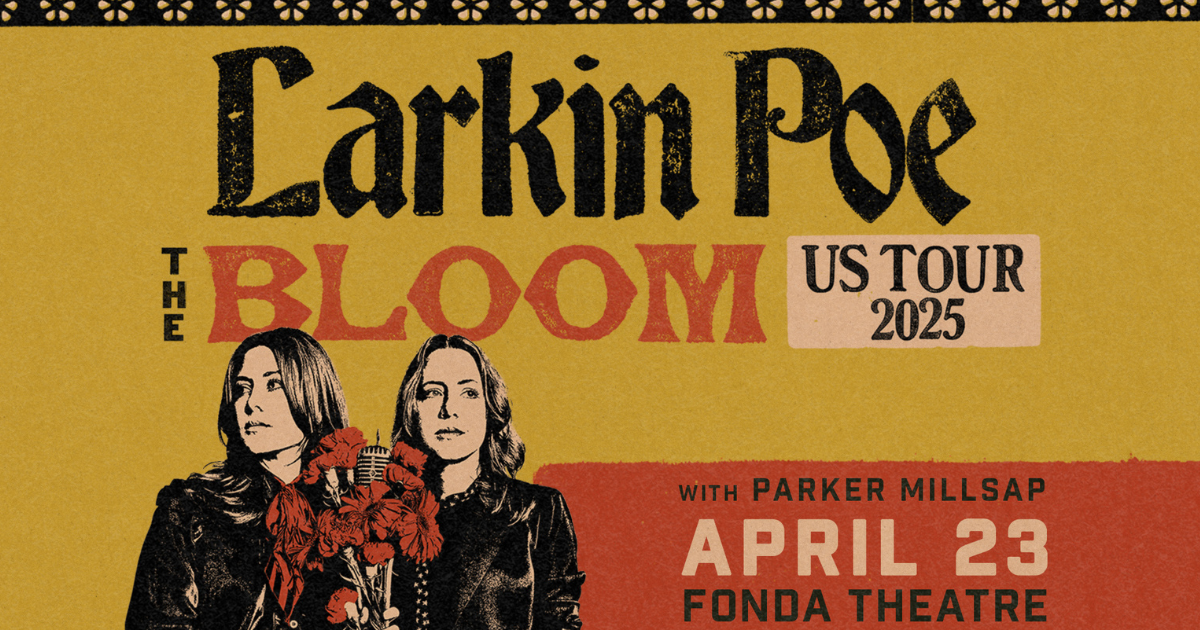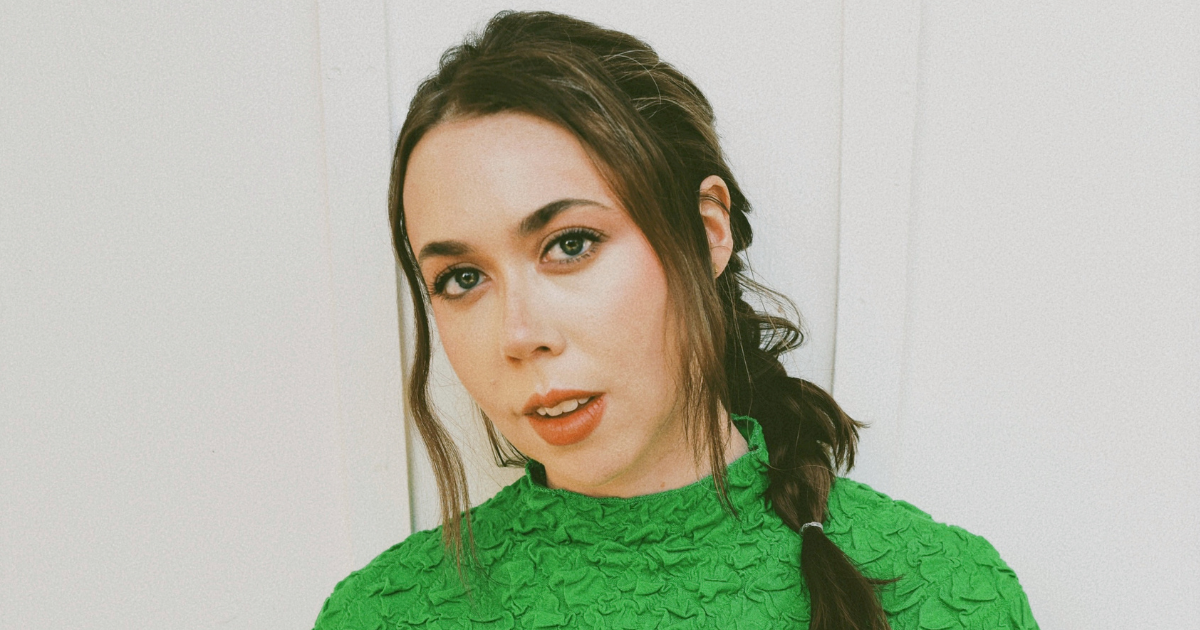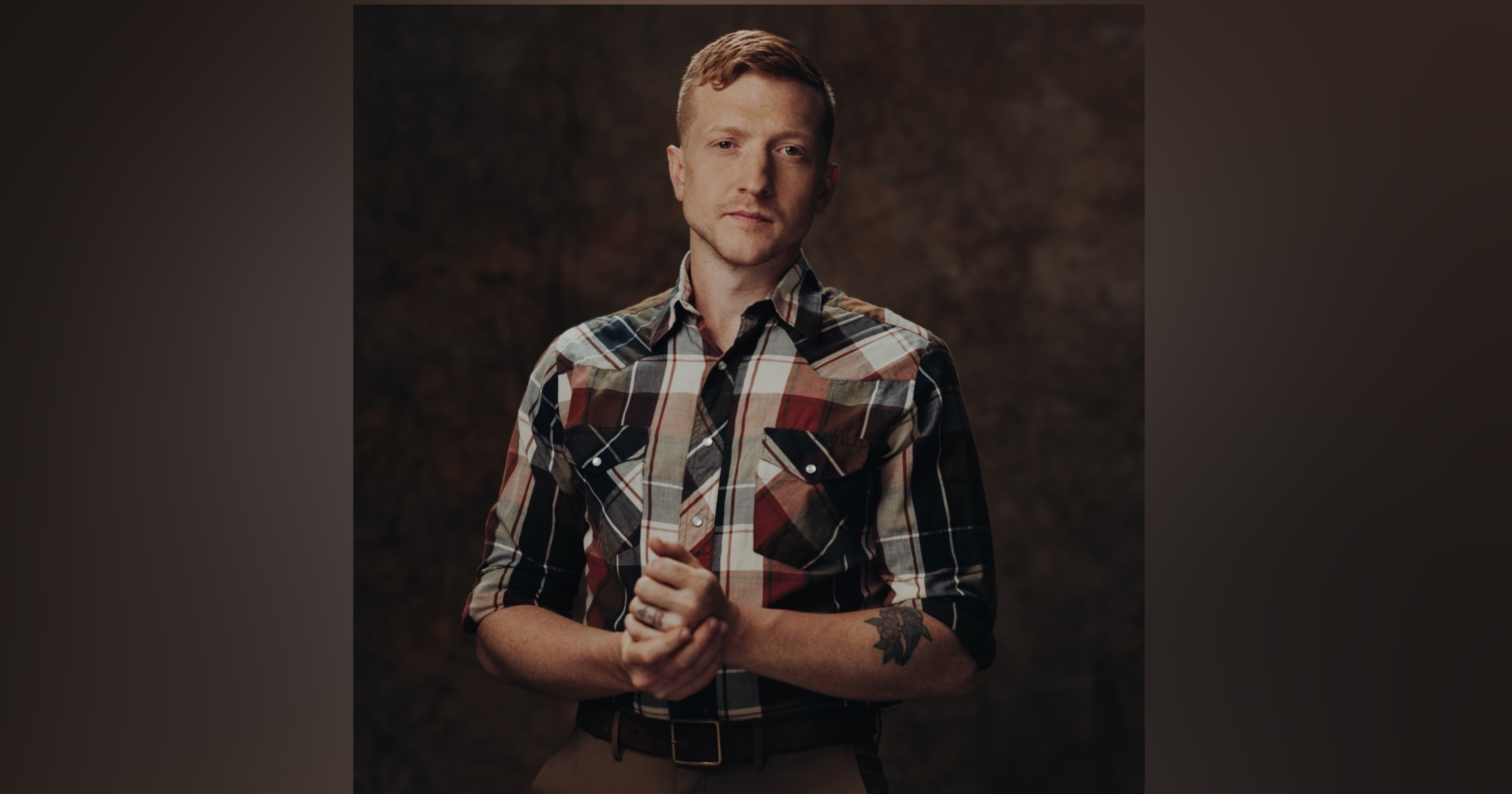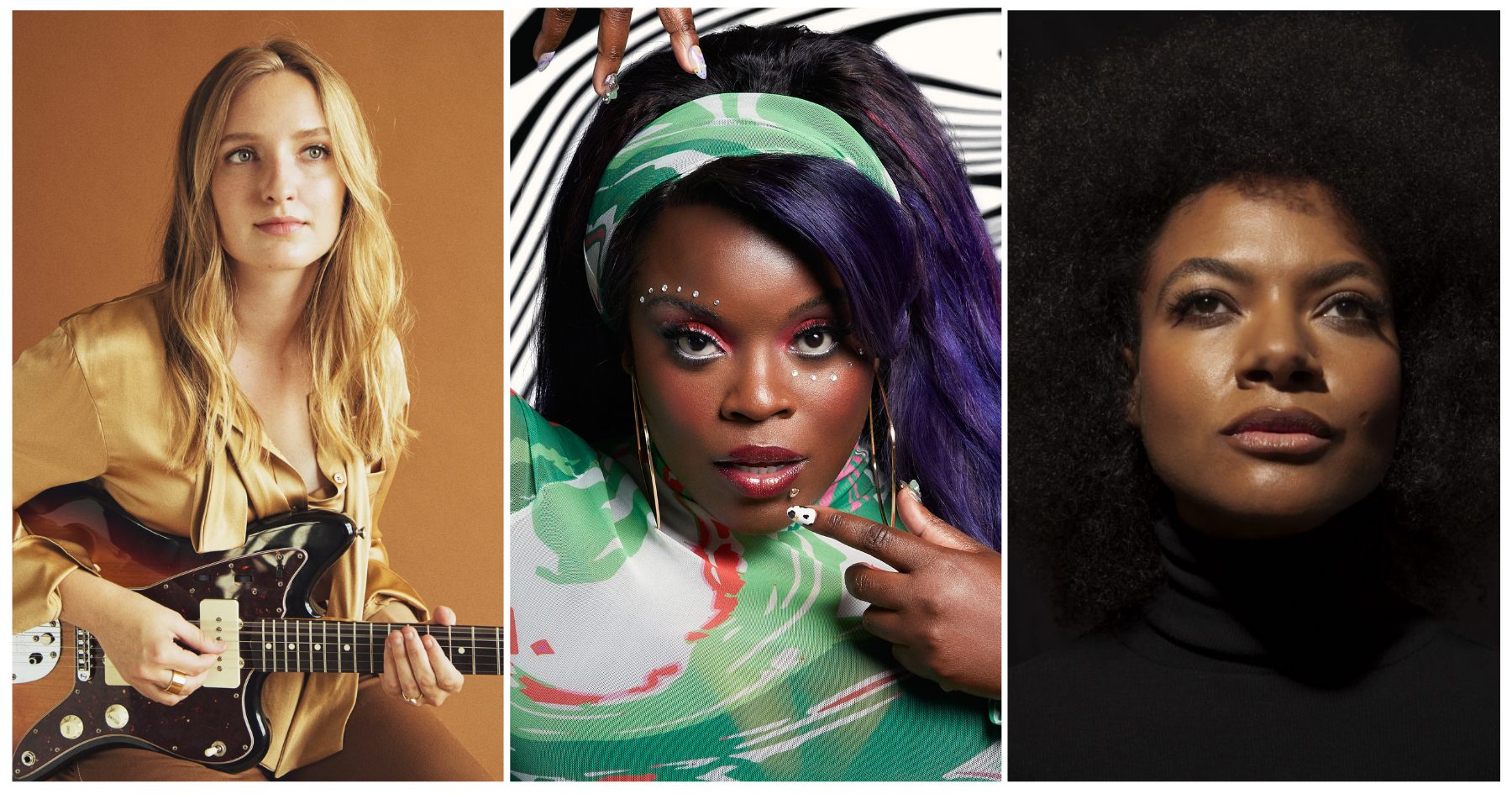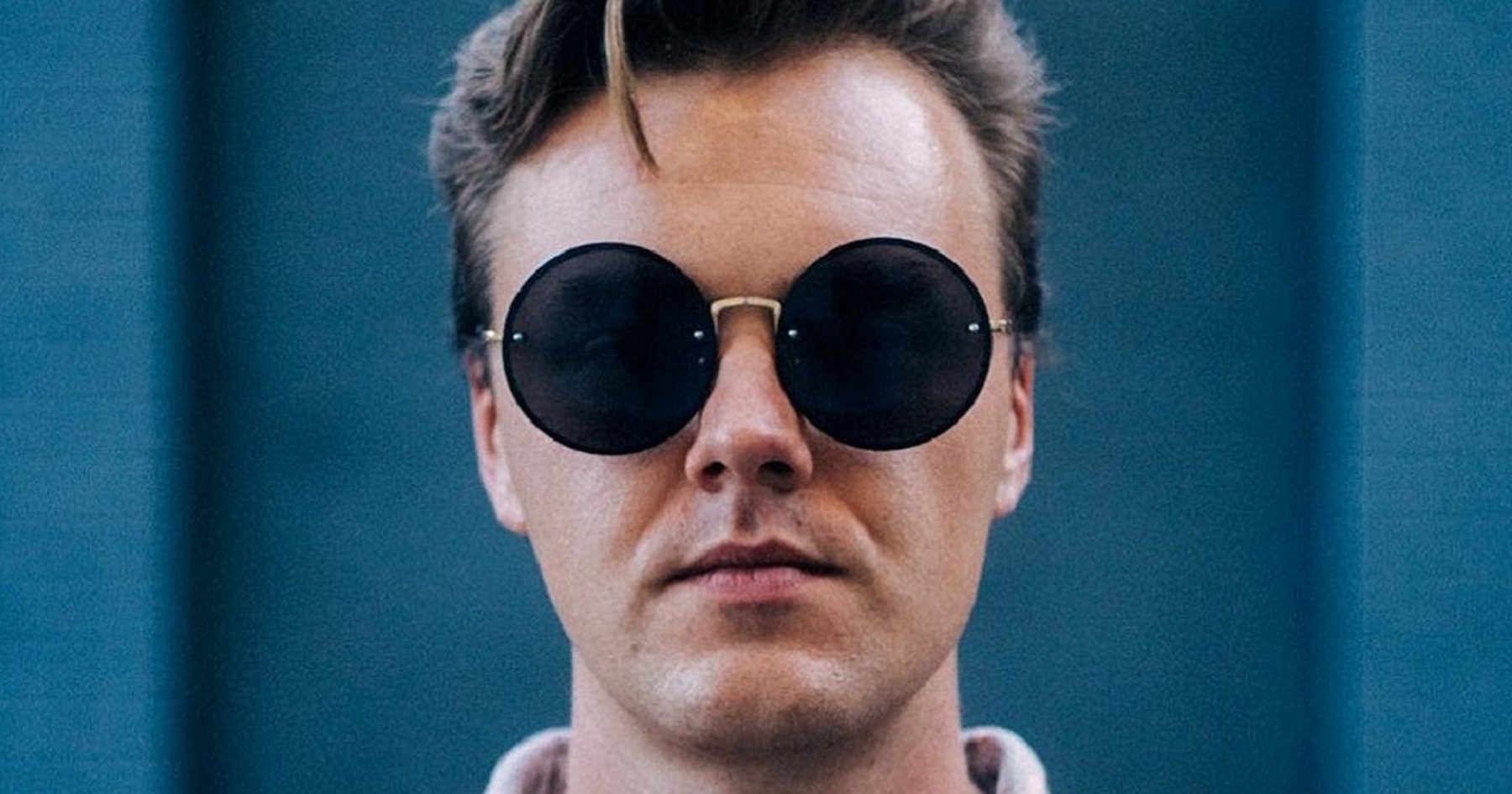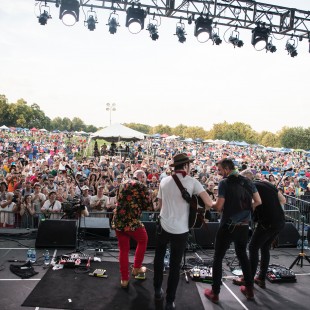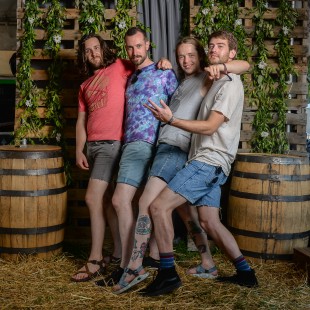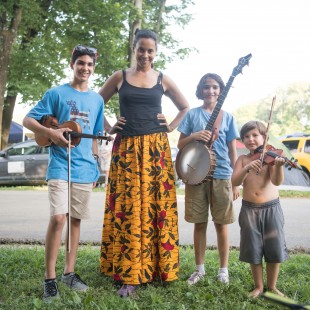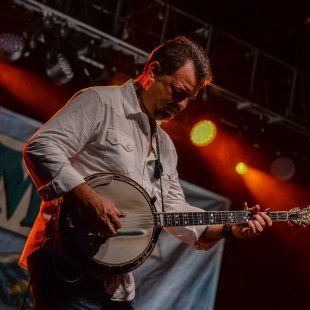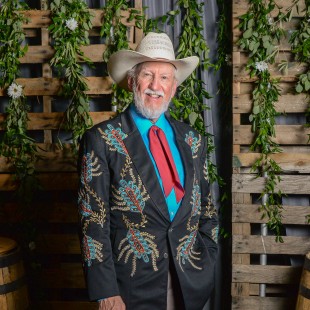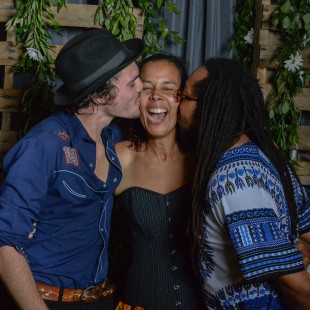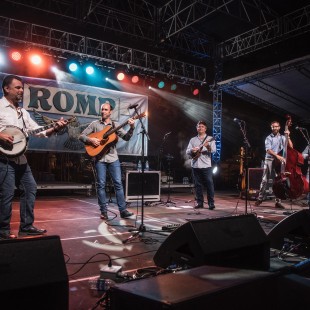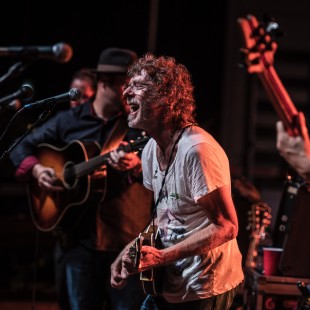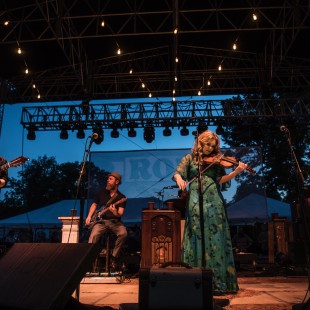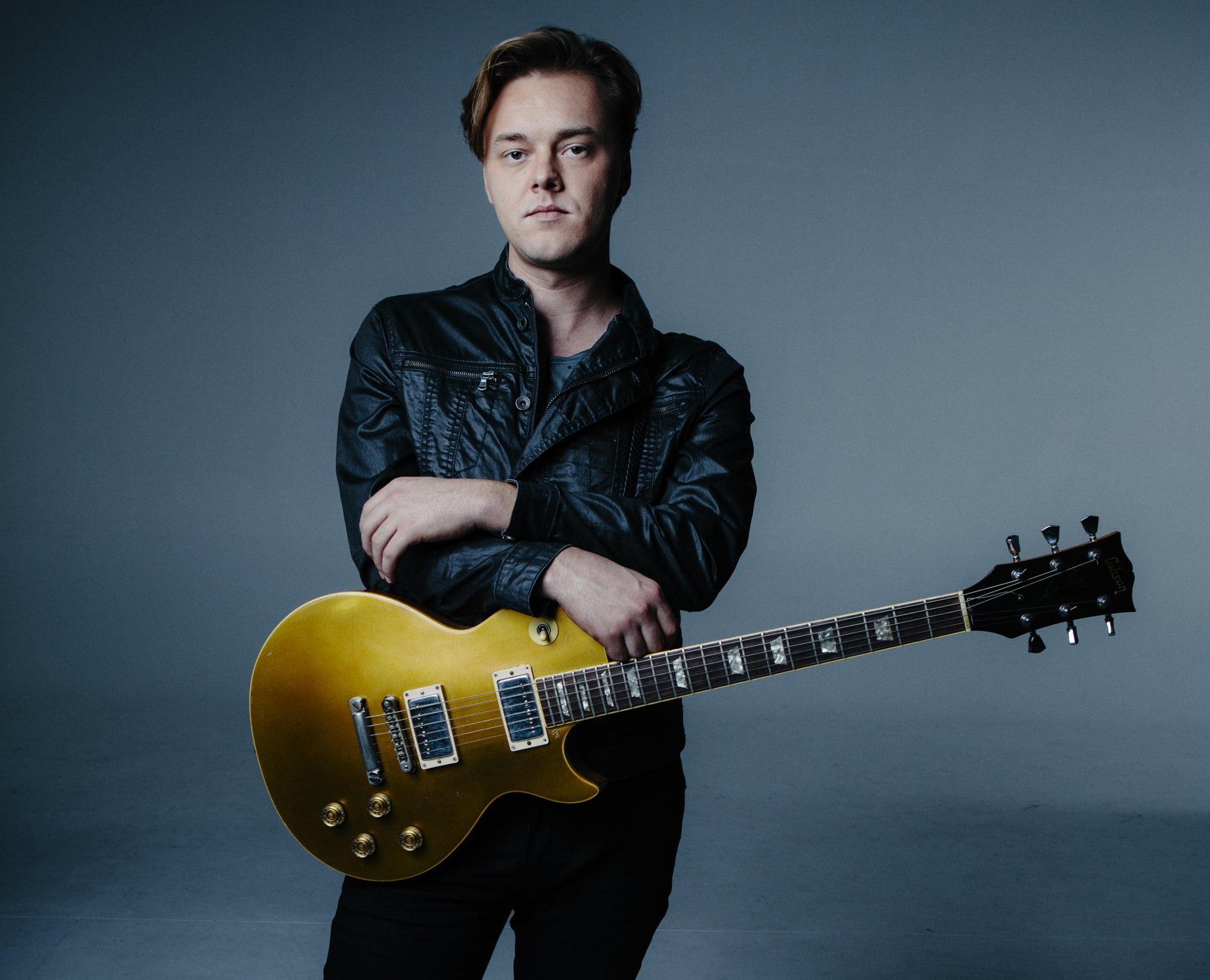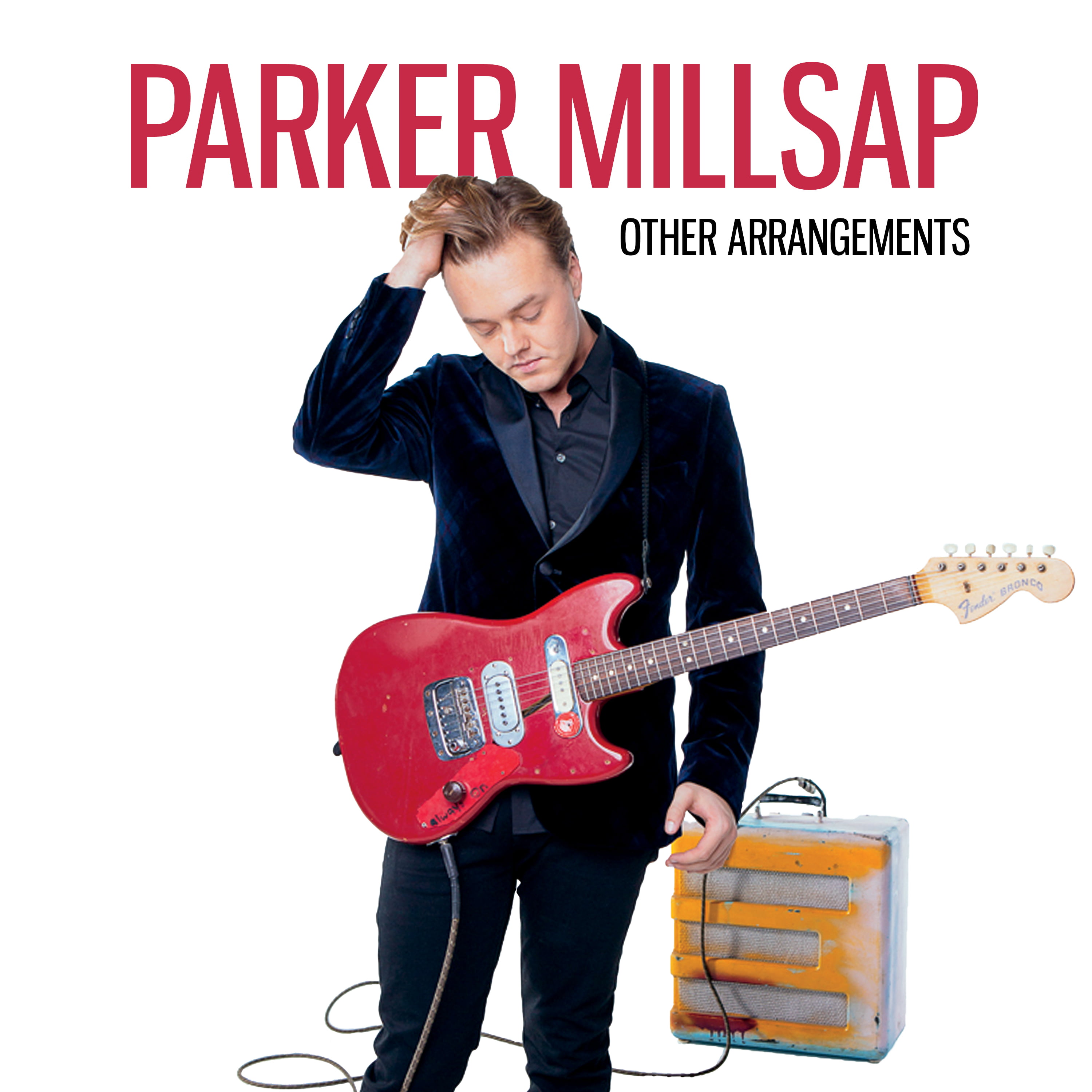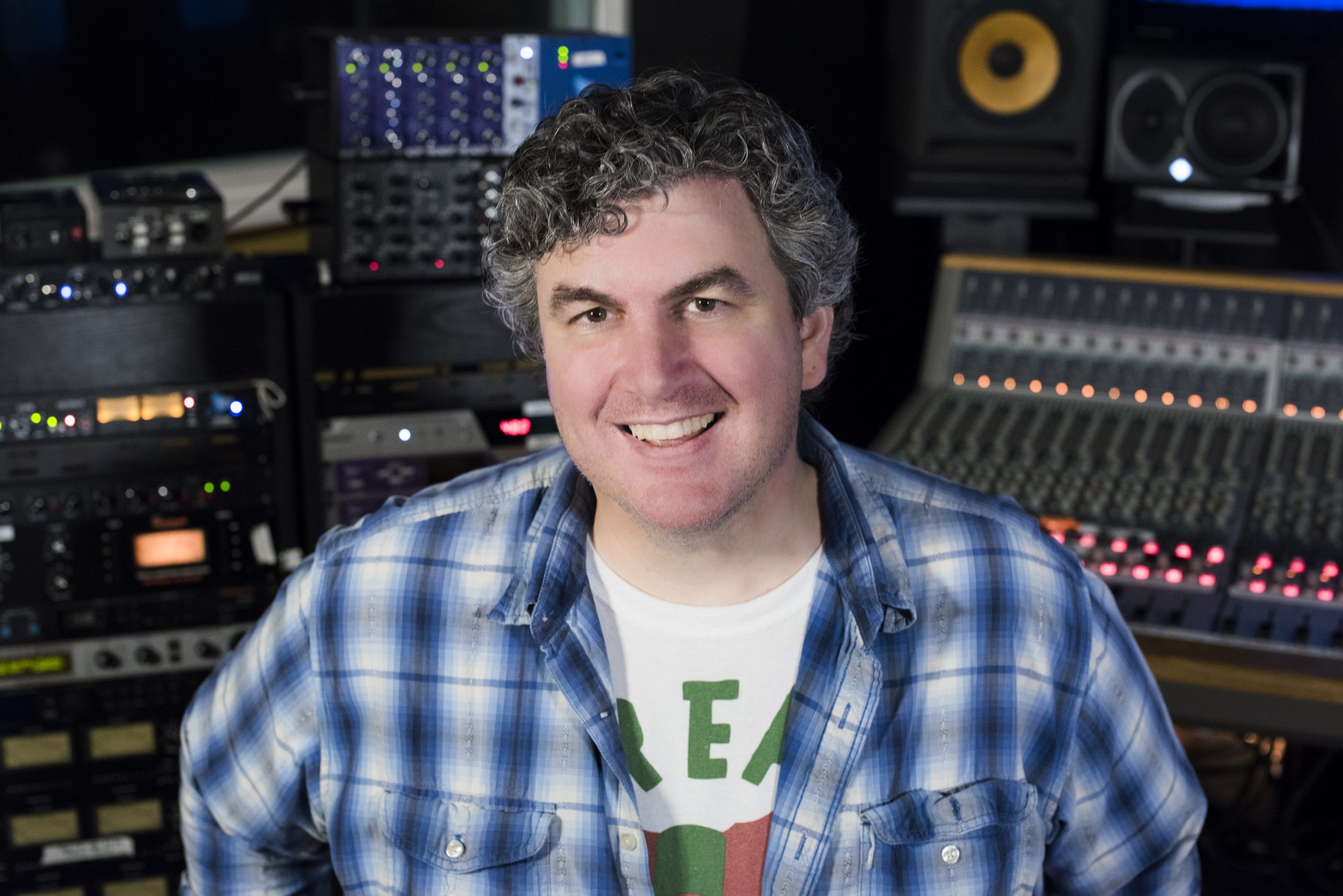Tag: Parker Millsap
Explore the Essential Songs of Sarah Jarosz’s Discography
Stripping away convention, honing in on narrative, and keeping complex melodies afloat with her ethereal vocals, Sarah Jarosz is a superlative presence in the roots music landscape. The daughter of two schoolteachers hailing from Wimberley, Texas, she began learning to play the mandolin at age 9. By the time she turned 12, Sarah was already gracing stages alongside the likes of musical giants David Grisman and Ricky Skaggs.
Her multi-instrumentalist capabilities and songwriting proficiency only grew from there; at the age of 16, Jarosz signed a deal with Sugar Hill Records and released her first album, Song Up in Her Head, in 2009. This critically acclaimed record would be the first of what now surmounts to seven full-length, tremendously lauded projects. Polaroid Lovers, Jarosz’s latest and the muse of her current tour, is set to be released on January 26, 2024.
Over the span of nearly two decades spent recording and touring, Sarah Jarosz has established herself as a foundational thread in the tapestry of modern roots music. From impeccable collaborations (with Punch Brothers, David Grisman, Sierra Ferrell), to forming a supergroup alongside Aoife O’Donovan and Sarah Watkins (I’m With Her), to a whopping 5 hours and 45 minutes of music published under her name, Jarosz stands firmly in her power. As she forges ahead, she only continues to outdo herself.
While her entire catalog is sure to edify any listener, this compilation showcases some of Jarosz’s most essential tracks. Tracing the arc of her musicianship from adolescence to adulthood, the following 17 songs demonstrate the particular sonic maturity, lyrical astuteness, and emotional evocation that span all she creates.
“Mansinneedof”
From Jarosz’s first album, Song Up in Her Head, this indelible instrumental boldly answers the question, “Can a mandolin be a lead instrument?” with a resounding, “Of course!” The first of many Grammy nominations acquired throughout her career, this tune was considered for Best Country Instrumental in 2009. Impossibly advanced beyond her years, Jarosz’s nimble and articulate melody is akin to a sonic coast through star-studded galaxies.
“Come On Up To The House”
In a clear demonstration of the range of her musical influences, the most-streamed song from Sarah’s inaugural album is a cover of Tom Waits’s “Come On Up To The House.” Her cool, slippery voice lends a new angle to the iconic tune. Paired with astute backing vocals from Tim O’Brien and a slick fiddle solo by Alex Hargreaves, this song grooves right along – an ingenious, albeit unlikely, bluegrass cover.
“Annabelle Lee”
Jarosz’s sophomore album, Follow Me Down, is latent with a mystical quality that reaches towards the ethers, shepherded into expansiveness by a creative spectrum of influences. The third track, “Annabelle Lee,” features lyrics adapted from the illustrious Edgar Allen Poe poem of the same name. Jarosz sets the eerie tale against a conglomerate of haunting textures – the heightened pace and drums evoke a sense of urgency while Jerry Douglas makes his lap steel wail, a somber cello moans, and Dan Tyminski’s backing vocals lend fullness to the ravenous depths of this dark tune. It is also worth noting that Jarosz performed and recorded this tune, very fittingly filmed in an old hunting lodge in the Scottish Highlands, for the Transatlantic Sessions in 2011. (Watch above.)
“The Tourist”
Sarah sure knows how to pick a cover. From Prince to the Decemberists to Joanna Newsom, she can masterfully braid her grace and artistry into anything. “The Tourist” offers Jarosz’s take on Radiohead, an influence cited among many of Jarosz’s contemporaries, including Madison Cunningham and Chris Thile. In fact, Punch Brothers provide the musical backdrop on this track, their syncopated rhythms and blustery fills meeting Jarosz and Thile’s airtight harmonies to create a sense of whirling, palpable, delicate angst.
“Build Me Up From Bones”
Off of her Grammy-nominated third album, this titular track received an additional nom for Best American Roots Song of 2014. This song is SJ’s most popular of all time, having racked up a total of 70.7M streams on Spotify. Here, Jarosz’s songwriting forges into new territory; her lyrics are both poetic and measured, imbued with textures of velvety longing. The form matches the content, from Aoife O’Donovan’s dewy harmonies to the pizzicato string section to the gorgeous cello solo. Effectively, listeners are bathed in a most intimate listening experience that beckons infinite re-listens.
“1,000 Things”
In another track off of Build Me Up From Bones, here SJ shares songwriting credits with the legendary Darrell Scott. The result? Pure synastry. Underscored by pulsating Celtic rhythms, this uptempo earworm says 1,000 things despite its brevity.
“House of Mercy”
This tune, along with the album carrying it – Undercurrent – won Sarah her first two Grammys in one night. “House of Mercy” was crowned Best American Roots Performance of 2017, and it was indubitably worthy. Jarosz shares songwriting credits with Australian singer-songwriter Jedd Hughes, and together they achieve a dark story arc as the encumbered narrator addresses an unwanted visitor. Jarosz opens up her sound into cutting, fierce Americana twang – effectively offering audiences a new layer to her multitudes of sound.
“Jacqueline”
The closing track of Undercurrent is stark, honest, and bewildering. The song is named after the Jacqueline Kennedy Onassis Reservoir in New York City where Jarosz, who once lived nearby, would often do her pondering. Accompanied solely by an electric guitar, Jarosz’s voice is agile and glimmering as liquid silver. She muses over the reflective surface and projected companion while disclosing her own state of unease, immersing listeners in an intimate, unyielding pensiveness.
“Your Water” (with Parker Millsap)
The first of a two-single release titled the Luck Mansion Sessions (2017), SJ here collaborates with fellow singer-songwriter and multi-instrumentalist Parker Millsap. The track, written and originally released by Millsap, is delivered as a duet. The groove opens up into a soul-type feel, allowing for Sarah to showcase a more raw, bluesy, unmeasured latitude of her voice.
“See You Around”
“See You Around” is the title track off of supergroup I’m With Her’s first and – to every listener’s chagrin – only full-length album. In 2018, Jarosz linked up with two of the most astounding women in roots music, Aoife O’Donovan and Sara Watkins, to form a trio of unadulterated excellence (it should be noted that that group won Americana Music Association’s Music Duo/Group of the Year). The album waffles between the three songwriters’ contributions, with each vocalist singing lead on an approximately even number of tracks. “See You Around” is driven by Jarosz’s signature poetic lyrics and fluttery melody, elevated to new horizons by the pristine, angelic blend of harmonies from Watkins and O’Donovan. The musical chemistry these women share evokes the divine; every single song on this album delivers listeners into the sublime.
“Johnny”
For her also Grammy-winning fifth studio album, World on the Ground (2020), Sarah Jarosz invites listeners to experience an array of vignettes; her songs on this album, more than ever, become vehicles for potent storytelling.“Johnny” is the second of three tracks on the album named, presumably, for a character the song aims to illustrate. Jarosz has said that during this album, she “[Tried] to take a step back and look out at the world in my songwriting, rather than looking inward,” and spent much time constructing the album as a patchwork of memories from her hometown in Texas, both faithful and fictionalized.
“Johnny” conveys the psychological landscape of a slightly drunk, slightly disillusioned man who is “just waitin’ on the stars/ that will never align.” It’s all slightly devastating, yet the melody latches onto an unforgettable earworm of a hook uplifted by its folk-pop flavor. Jarosz incorporates a strings section alongside drums, electric guitar, and mandolin, seamlessly using the nuances of sound to bolster the complex mundanities of Johnny’s life.
“Pay It No Mind”
Jarosz shares the songwriting credits on “Pay It No Mind” (also off of World on the Ground) with the renowned John Leventhal, who also produced the album and plays a slew of instruments sprinkled throughout. The song begins with just Sarah and a pensive guitar riff, musing upon a bird and her ponderings. The song then builds in dynamics, layering percussion and eventually a full orchestration of instruments and vocals. It’s slick, it’s sly, and it looks at the world with a cool sense of distance.
“I Still Haven’t Found What I’m Looking For” / “my future”
In the midst of quarantine, Sarah Jarosz committed to staying connected with fans by using Garageband and her home microphone to record one cover each week from July to October of 2020. In January 2021, she released two of the covers, U2’s “I Still Haven’t Found What I’m Looking For” and Billie Eilish’s “my future,” on streaming services. These barebones covers are a time capsule of a moment drenched in emotion, isolation, and fear. Catharsis swells through the minimalistic recordings – Jarosz cradles her whole soul into these songs, and the results are absolutely astounding.
“Mama”
For her sixth full-length studio album, Blue Heron Suite (2021), Sarah Jarosz released a song cycle that she first premiered at Freshgrass in 2017, whereupon she was awarded with the Freshgrass Composition Commission. At the time, Sarah was reckoning with her mother’s cancer diagnosis and reflecting upon childhood trips to the town of Port Aransas, Texas, which at that time had recently been severely affected by Hurricane Harvey. Named for the Great Blue Herons she and her mother used to observe along the town’s shore, this album is imbued with love and hope in its deepest forms. “Mama,” the opening track, is an utterly gorgeous, pared-down arrangement of voice and guitar – a most gentle and tender ode to Jarosz’s mother, who is thankfully now in remission.
“For Free” (with David Crosby)
An astonishing songwriter and pioneer of three-part harmony in American roots/folk music as we know it, David Crosby was a long time supporter of Sarah Jarosz’s work up until his passing last January. Sarah graced the title track of Crosby’s final full-length solo album, For Free (2021). The two sing the entirety of this Joni Mitchell cover in tight harmony, their voices mirroring one another perfectly. The pared back solo piano accompaniment highlights the duo’s vocal finesse; every riff is intertwined with precision and elegance.
“Jealous Moon”
“Jealous Moon” was the first of four singles SJ released from her upcoming album, Polaroid Lovers (out this Friday). Co-written alongside Daniel Tashian, the record’s producer, Sarah remarks of the song, “I’m always seeking to push myself into new sonic territory, and this song gave me permission to not hold back.” In this track, she boldly steps away from her traditional acoustic tethers and moves towards a more pop-rock-twang fusion. Jarosz successfully elicits a sense of novelty while still embodying the sense of fullness and depth she puts into all she creates – reminding us that we still have yet to see the full bloom of her artistry.
Photo Credit: Shervin Lainez
Tyler Childers Stunning “In Your Love” Music Video Was Written by Silas House
Traditional country phenom and Kentuckian Tyler Childers has announced his upcoming album, Rustin’ In The Rain (available September 8, 2023), with a brand new single and music video, “In Your Love.” Written and creative directed by New York Times bestselling author Silas House, the video tells a gay love story between two working class, Appalachian men – played by queer A-list actors and celebrities Colton Haynes and James Scully. The visuals for “In Your Love” tell one of country music’s most prominent and visible LGBTQ+ narratives to date, entering an industry landscape that has become more and more (openly) queer over the past decade.
“In Your Love” reminds of songs and albums released not just by left-leaning, more mainstream artists like Childers and Parker Millsap, but also by queer artists themselves, telling working-class stories and histories just like that constructed and depicted by House and director Bryan Schlam. In 2015, gay banjo player, singer-songwriter, and fellow Kentucky-resident Sam Gleaves released a landmark album, Ain’t We Brothers, which dripped with the exact same lived experiences and soot-tinged patina that inform Childers’ new video. In the past couple of years, releases by LGBTQ+ identified music makers like Amanda Fields, Willi Carlisle, Adeem the Artist, Amythyst Kiah, Jaimee Harris, and more trod similar ground. It’s notable still that an artist – however outlaw- or fringe-identified – as mainstream as Tyler Childers and with as broad a fanbase as his would choose to not only highlight queer, working-class storytelling, but to do so in a way that normalizes and re-centers these ways of being in Kentucky, the South, and Appalachia.
Rustin’ In The Rain will be released via RCA Records on Childers’ own imprint, Hickman Holler Records, on September 8. Via press release, Childers describes the inspiration that birthed Rustin’: “This is a collection of songs I playfully pieced together as if I was pitching a group of songs to Elvis. Some covers, one co-write, and some I even wrote in my best (terrible) Elvis impersonation, as I worked around the farm and kicked around the house. I hope you enjoy listening to this album as much as I enjoyed creating it. Thank you. Thank you very much.”
Clearly, the legacy of “The King” is merely one way drama, mystique, nuance, entertainment, and Southern-ness coalesce within this new project from one of the most exciting voices and perspectives in country.
Photo Credit: Sam Waxman
The BGS Radio Hour – Episode 207
Welcome to the BGS Radio Hour! Since 2017, this weekly radio show and podcast has been a recap of all the great music, new and old, featured on the digital pages of BGS. This week, we bring you new music from our Artist of the Month, Allison Russell, an exclusive live performance by Madison Cunningham from BGS’ Whiskey Sour Happy Hour, and much more. Remember to check back every week for a new episode of the BGS Radio Hour.
Coming out of COVID isolation with fingers crossed and masks on, many artists are releasing new and exciting music. We’re particularly thrilled about Sunny War’s latest release, Simple Syrup. We caught up with the LA-based guitarist and singer for an edition of 5+5 and talked everything — from Elizabeth Cotten’s guitar playing to eating black-eyed peas with Nina Simone.
Singer-songwriter Ted Russell Kamp originally wrote “Lightning Strikes Twice” in the style of Billy Joe Shaver, as a honky tonk number. But, for his upcoming album Solitaire, he decided to rework the track, bluegrass style.
A student of singer-songwriter, multimedia artist, and scholar No-No Boy (AKA Julian Saporiti) once called his song “Gimme Chills” a “fucked up love letter to the Philippines.” No-No Boy agreed. The track is part history lesson and part tribute.
Yola – “Diamond Studded Shoes”
Yola’s roots-pop outing “Diamond Studded Shoes” is a song that explores the divides created to distract us from those few who are in charge of the majority of the world’s wealth. It calls on all of us to unite and turn our focus to those with a stranglehold on humanity.
BGS recently caught up with Kentucky’s own Dale Ann Bradley, discussing her recent album, Things She Couldn’t Get Over — her first release since departing group Sister Sadie. Each of the songs on the project deal with hard times, and finding the courage that gets us through. “Yellow Creek,” a song about the forced removal of Native Americans from their land, finds Bradley giving us a reminder to walk with empathy.
“Where I Belong” by singer-songwriter Josephine Johnson was inspired by characters from British Navy novels set during the Napoleonic wars. Love and high seas adventure, to be sure!
Inspired by their song “Gold,” The Wandering Hearts created a Mixtape for BGS, entitled The Golden Tonic, it’s a selection of songs that have helped them through tough situations, inspired them, and take them back to specific moments in time. They hope that the Golden Tonic will work its magic on the listener after this heavy and hard year.
In a recent 5+5, multi-instrumentalist and singer-songwriter Eli West discusses the influence of Paul Brady and Irish folk music, understated chaos in visual art, and drunk BBQ with Sting and Mark Knopfler.
Allison Russell – “Nightflyer”
Our Artist of the Month Allison Russell has already made a mark on the modern roots scene through various powerhouse groups, like Birds of Chicago and supergroup Our Native Daughters. Now, she’s stepping out with her first solo record, Outside Child. Stick around all month long for exclusive content from Russell.
Bhi Bhiman reimagines iconic rock song “Magic Carpet Ride” in the style of old country blues players – artists like Mississippi John Hurt, Lightnin’ Hopkins, and others who’ve played a huge role in Bhiman’s evolution as a guitarist.
Parker Millsap, one of our recent guests on The Show On The Road, is a gifted singer-songwriter who grew up in a Pentecostal church and creates a fiery gospel backdrop for his tender (then window-rattling) rock ‘n’ roll voice.
Madison Cunningham – “L.A. (Looking Alive)”
Last spring, on our debut episode of Whiskey Sour Happy Hour, Los Angeles-based, Grammy-nominated guitarist and singer-songwriter Madison Cunningham kicked off the entire series with an acoustic rendition of “L.A. (Looking Alive).”
From bluegrass mad scientist Stash Wyslouch, formerly of progressive string band the Deadly Gentlemen, here’s a traditional number turned upside down, taking a Bill Monroe tune and contrasting it with polytonal backup. Wyslouch told BGS that while he gravitates towards gospel standards in the bluegrass world, his own style drifts to the absurd and unexpected. Like a bluegrass Frank Zappa!
Bob Malone – “The River Gives”
Singer-songwriter and pianist Bob Malone wrote “The River Gives” after the devastating 2016 flooding in West Virginia, but he never had a chance to produce the track like he wanted to – until now!
Marty Stuart’s new project, Songs I Sing In The Dark, is a collection of twenty songs that he curated that helped him through the tough times that we all saw in 2020. Stuart says this Willie Nelson song has followed him around since he first heard it over twenty years ago. “I think of it as an old friend, same as Willie. It’s a friend for the ages, and an excellent song to sing in the dark.
Photos: (L to R) Madison Cunningham by Claire Marie Vogel; Yola by Joseph Ross Smith; Allison Russell by Marc Baptiste
The Show on the Road – Parker Millsap
This week, we feature a conversation with one of the rising stars in our current roots music renaissance: Parker Millsap, a gifted Oklahoma-born singer-songwriter who grew up in a Pentecostal church and creates a fiery gospel backdrop for his tender then window-rattling rock ‘n’ roll voice.
LISTEN: APPLE PODCASTS • SPOTIFY • STITCHER
His brawnier, self-titled record from 2014 showed his rebellious electric side coming to the fore, followed by his beloved, fire-and–brimstone bopping breakout The Very Last Day two years later, which confronted our country’s obsession with destruction. Then there was the toothier, glossier, pop-leaning Other Arrangements, which finally brings us to his soulful newest record, Be Here Now. It’s not hard to see that this young songwriter is coming into his prime years. With a new maturity and wisdom behind his writing, standout, incendiary songs like “Dammit” are allowed to unfold in a distortion-dipped, John Lee Hooker meets U2 slow-burn build; never resolving, never relenting while he confronts the tough truths and hypocrisies that are threaded into our modern lives. What is our purpose? What can we do about the violence and greed all around us? Without pushing or preaching, the song is trying to convince its listener to never give up in making our broken world a little better every day.
What always set Millsap’s songwriting apart, though, isn’t just his ability to get us fired up with stomping roots-n-roll hysterics (though he’s pretty great at that), it’s the tender left-turns he takes when he goes acoustic, bringing the volume down and the emotion up. Reminiscent of a southern Paul McCartney, his scratchy, soulful tenor shines most on his gorgeous ballads — think “Jealous Sun” (from The Very Last Day) as his own “Yesterday” or on the newest record, the psychedelic and heart-string pulling “Vulnerable,” which asks us all to try and see our own weaknesses and past wounds as potential strengths.
While it is bittersweet to not be able to kick off his new record release this April with a typical cross-country tour, on April 23 Parker will be playing Be Here Instead in its entirety with his longtime band live on Mandolin — which you can stream from anywhere.
Photo credit: Tim Duggan
ROMP 2018 in Photographs
The Bluegrass Hall of Fame and Museum’s annual ROMP Festival celebrated its 15th anniversary with more than 27,000 people attending the four-day bluegrass roots and branches music event at Yellow Creek Park in Owensboro, Kentucky. Those lucky 27,000 were treated to a a sunset performance by the iconic Alison Krauss, a split set of bluegrass and country by newly-minted Country Music Hall of Famer Ricky Skaggs, a rowdy and non-stop dance party by Ireland’s We Banjo 3, a rocking finale performance by the ‘Father of Newgrass’ Sam Bush, and much, much more. Check out our photo recap to relive the highlights or to find out what you missed.

Lede photo by Alex Morgan
Hangin’ & Sangin’: Parker Millsap
From the Bluegrass Situation and WMOT Roots Radio, it’s Hangin’ & Sangin’ with your host, BGS editor Kelly McCartney. Every week Hangin’ & Sangin’ offers up casual conversation and acoustic performances by some of your favorite roots artists. From bluegrass to folk, country, blues, and Americana, we stand at the intersection of modern roots music and old time traditions bringing you roots culture — redefined.
With me today in the Writers’ Rooms at the Hutton … Parker Millsap.
Howdy, everybody.
Welcome!
Thank you! Good to be here.
I’m so glad to have you. Tried to get you on the last record and we couldn’t work it out. But here you are. It’s perfect. It’s all meant to be, the way I see it.
Absolutely.
Congratulations on this new record, Other Arrangements.
Thank you!
…
I first saw you play four years ago. You did a couple shows with Hayes Carll — the Basement and Music City Roots. The people at Music City Roots just about flipped out. Leapt to their feet. I think you got a standing ovation after every song.
[Laughs] It’s only a standing ovation at the end. Otherwise, it’s just an ovation.
[Laughs] Is that true? Even if they stand? Because they were on their feet, man.
Yeah. They save the standing for the end.
You were doing an acoustic trio, but even then, there was a fire in your performance. You’ve never been this mellow, folky guy. You have some mellow songs, but the overall sense. Even knowing that, on my first listen through to Other Arrangements, I was a little bit surprised. Then I paused and thought, “No. This makes sense. The grittier parts make sense.” Is that how you see it, too?
[Mock yells] “I don’t want to be the villain in your dreams anymore!”
[Laughs] Yeah, exactly! And, really, like any vocalist or musician, you want to cover all of the emotions — the whole gamut. You want to be able to make people feel sad or make people feel elated or whatever it is. But, yeah, this record, I just wanted to kind of rock out. It had been a minute.
Well, each record has been, not just a step forward, but a leap, I feel like, in terms of the production, in particular. I think the songwriting has been consistent and solid the whole time. Was that your vision or has it just been the natural flow?
I think it’s just getting better at it. Because I’ve thought about it. I’ll go back and listen to the old records. I just wasn’t as good. [Laughs] I like to think I’m getting better at it. And I try to make each record a little better and maybe a little closer to me. This record, lyrically, I feel like is less abstracted. Previously, I wrote a lot of character studies and story songs and things like that, where I could kind of take things that I was thinking and disguise them in a story of somebody else, put it at arm’s length. I still had to get into it, but could hold it at arm’s length and say, “That’s not about me.”
But, this record, is just a little more personal. I’m not trying to dress it up as much. It’s just like, “Here are some emotions, as a song.” [Laughs]
Watch all the episodes on YouTube, or download and subscribe to the Hangin’ & Sangin’ podcast and other BGS programs every week via iTunes, Spotify, Podbean, or your favorite podcast platform.
Photo credit: David McClister
Parker Millsap, ‘She’
Last week, country superstar Keith Urban released his new album, which includes a song called “Gemini.” Supposedly written for his wife, Nicole Kidman, it boasts a line that is the definition of cringe inducing: “She’s a maniac in the bed, but a brainiac in her head,” it goes. Aside from the fact that it’s redundant (you can’t be a brainiac in your leg or your elbow, last time we checked) it’s one of many examples in modern Music Row writing that belittles a woman’s worth while trying to be a tribute to her greatness. It shouldn’t be a surprise to anyone that a woman can be both smart and sexy. But writing about a partner, regardless of gender, shouldn’t be off-limits, either. Romance is a cornerstone of music, and that’s a fine thing indeed — and artists should be able to write tributes to their lovers or loved ones without shades of sexism.
Parker Millsap’s “She,” from his new record, Other Arrangements, is a fine example of how to write and sing about a partner without ceding to demeaning language that praises a certain female while still keeping her safely in her place. In “She,” Millsap, to a noodling and bluesy guitar, credits the woman in his life with keeping him in line, offering him strength, and putting the pressure on to be a better man. “She’s no question; she’s the answer,” Millsap sings, bouncing lightly through the lyrics and in a near-duet with the guitar itself. The she in “She” is a brainiac, too, it seems — in her head (or elsewhere). But in Millsap’s hands, her greatness isn’t in spite of anything at all. It just is.
BGS Takes Britain with the Long Road Festival
Britons, rejoice. We know it’s not been an easy year for you, what with Brexit, and Prince Harry being taken off the marriage market. But we have good news. The first-ever BGS event hits the UK this summer, and it’s going to be, as they say over there, bloody brilliant.
BGS’s overseas debut follows the launch this week of the Long Road, a major new festival taking place September 7-9, 2018. A celebration of everything Americana, the Long Road is set to bring a slice of the South to the English countryside. For three days, the elegant grounds of Stanford Hall — a 17th-century stately home in Leicestershire — will rock out to the sounds of dozens of country and roots artists, including Lee Ann Womack, the Wood Brothers, Parker Millsap, and the Lone Bellow. And, when it’s not too busy, it’ll be doling out bourbon, moonshine, and Southern cooking, and inviting you to swim in its beautiful lake.
On Sunday, September 9, BGS will takeover the Long Road’s Honky Tonk stage to celebrate some of the fiercest females in modern roots music. The all-female line-up includes artists making waves on both sides of the Atlantic. From the U.S., we’ll be bringing you Ashley Campbell, Angeleena Presley, and Amythyst Kiah, while breakthrough British acts Danni Nicholls, Cardboard Fox, and the Worry Dolls will be flying the home flag. Look out, too, for Australian singer/songwriter Ruby Boots.
This is a thrilling — dare we say, pivotal — time for American music in the UK. The Long Road is one of three brand new festivals celebrating roots music to open this summer, including the Black Deer Festival, headlined by Jason Isbell and the 400 Unit. In August, Rhiannon Giddens will curate the Cambridge Folk Festival for the first time, and the Guardian recently reported that this year’s Country 2 Country festival, at the O2 arena, has enjoyed a four-fold increase since it began in 2013.
With so much good stuff happening just a plane ride away, BGS has exciting plans to bring you more great music both from and in the UK. Keep your eyes peeled for future announcements.

The Producers: Wes Sharon
Wes Sharon was 11 when he bought his first punk record. He was just like any kid growing up in Oklahoma in the ‘70s, except he was fascinated by this music where adults acted like kids. “I went to this place called Peaches Records & Tapes. I remember this very well: The girl behind the counter had a perm. I asked her where the punk records were and, as bitchy as she could say it, she said, 'What’s punk?'”
The kid struggled to answer the question, but all he could come up with was, “Like, the Police?”
Fortunately, the clerk took pity on him and sent him out the door with the Clash’s London Calling under his arm. “I went home, read the lyrics, saw the F word.” To say it changed his life would be an understatement. “The Clash did everything. They did all kinds of music, and they made a lot of mistakes, too. That really informed my listening.”
The kid took that lesson to heart. As a teenager, he learned to play bass and joined as many punk bands as he could. Soon, he started recording other punk bands — obscure groups that pressed only 500 seven-inch singles or a handful of CDs. He took a job at Prairie Sun Recording Studio, just north of San Francisco. “I thought Tom Waits owned it,” Sharon says with a laugh. “But he didn’t.”
And, eventually, he moved back to Oklahoma, settled down, got married, and opened his own studio in Norman. True to his Clash fandom, he doesn’t just record punk; in fact, his name has been connected with a recent resurgence of Sooner singer/songwriters who marry country twang and folk sophistication. In addition to Parker Millsap’s 2014 self-titled debut, Sharon helmed both of John Fullbright’s albums: 2012’s Grammy-nominated From the Ground Up and his 2014 follow-up, Songs.
What these and Sharon’s other projects (including the Grahams, Pat Travers, and the Turnpike Troubadours) have in common is a sense of intensity, an emphasis on performances that can be almost punk in their volatility. Sometimes they are wild and raucous, as with Millsap; but other times, they can be restrained and quiet, as with Fullbright’s Songs. Taking the Clash’s example, Sharon draws from a wide range of styles and settings and techniques, giving the sense that anything is possible at 115 Recording.
Tell me about 115 Recording. What’s your studio like?
The space has been here forever — well, something like 40 years. It’s built inside a warehouse, sort of a box within a box. Different people have had different studios here. I rebuilt it for a guy about 10 years ago, and he ended up wanting to get out of the business, so I bought it from him in 2008. It has a bit of a punk rock vibe.
How do you mean? Graffiti on the walls? Toilets ripped out like CBGB?
Only that it reminds me of the places I worked when I did punk records. It’s quite a bit nicer than any of those records, actually. It’s set up a bit like Studio B at Prairie Sun, where I used to work in California. It’s a rock 'n' roll studio, and it had a Trident console in it. That was a real punk rock desk. A lot of recordings were made with that series in the ‘80s. Now I think they’ve got Pete Townshend’s old Neve in there. I have a desk that reminds me of that Trident. It’s a good room. I don’t think Beyoncé or somebody like that would be very comfortable, but the bands I work with think it’s great. It’s got everything I need and not a whole lot of what I don’t … other than pianos. For a guy who doesn’t play piano, I seem to own a lot of pianos and keyboards. It’s a good workspace. People come here to work. There’s not a whole lot to do besides that.
Does that tend to keep people focused on the work? There’s always trouble to get into in New York or Los Angeles.
That’s a good point. Sometimes I wish maybe a bar was closer, so that people would have a place to go. It’s not like we’re out in the sticks. We’re actually close to a lot of stuff. There are restaurants within walking distance, so you can check out for 15 minutes. But there’s not a huge amount of distractions. We’re not next to a strip club or anything.
When you left California, what brought you back to Norman?
When I first came back, it was because I had broken up with a girlfriend. That was it. I just needed to get out of town. I came home and was around the people I needed to be around to get through that. And then I started recording. I’d just finished a session that paid quite a bit, so I had some money. I moved in with one of my best friends, April Tippens, who was in a band called Radial Spangle. They had a record deal with Beggars Banquet. We made some recordings there and that got me started on the idea of working out of a house. I did that for a while and just ended up staying. Oklahoma in the ‘90s was pretty cheap. It was cheaper for me to live and work in Oklahoma and fly back to sessions in California than it was for me to live and work out there.
Eventually, I found a place in a warehouse — another box inside a box — and I worked there for a while. We christened it the Devil’s Workshop. That was all about my grandma. We weren’t Satanists or anything. She was always asking me, "What do you do again? You listen to music all day?" She used to say idle hands were the devil’s workshop, and my friends and I thought that was funny. We printed these shirts that said, "If it sounds like hell, it was recorded at the Devil’s Workshop." It became a popular place for people to work. That was in Oklahoma City, but then I ended up getting married and my wife started working for the University of Oklahoma. She’s got a real job. So we moved to Norman. Go Sooners.
Has there ever been a temptation to move to a bigger city, like Nashville or Los Angeles?
I did John Fullbright’s record in 2012, and it was nominated for a Grammy, so the two of us went out there for the ceremony. And I ran into Don Was. I’d never met him before, but he’s the kind of guy who’s always the coolest person in the room all the time. He knew about John’s record and his first question for me was, "Did you do that record in Nashville?" I said, "No, I did it in Norman." He says, "What’s in Norman?" "Well, I am." And he says, "Right on!" I thought that was the greatest answer.
People ask me this all the time. It’s tempting. But if you go to Austin or Nashville or some place like that, you’re just another dude who does the exact same job. There would be a million of me. There’s a different attitude here. You’re not going to have business meetings out here. It’s going to be pretty laidback. When people come here, they come to work. And when they want to go somewhere else, they take me along.
I’ve made small records for a really long time. I did bigger stuff at Prairie Sun and worked with a lot of great people. I got to learn a lot. And, honestly, I missed that. I missed working within the culture of a community. At the end of your session, you walk out the studio door and there’s another guy walking out of another studio door: "How did your day go?" "Well, I did this and I did that." You know exactly what they mean. I miss that. In smaller markets — I hate to use that term — there aren’t a whole bunch of studios, so people in the business don’t tend to communicate. I’ve tried really hard to change that.
How so?
I’m actually a partner in another room here in Norman. I don’t work out of that room, but I helped the guy get started. He had worked in Nashville and Austin and had come home. His focus is completely different from mine, and it was good to help him. If I’m going to talk about community, I have to put my money where my mouth is. And when we want to geek out over something, we have each other. There are actually some guys here in town that I really admire. Norman, of all places, has quite a few recoding facilities. Trent Bell has a place here. He used to play in the Chainsaw Kittens. We’ve been friends since we were 18.
So there is a small community there.
There’s a lot of good stuff going on here. Tulsa is the same way. There are all these little pockets of music scenes around the state. That’s the thing I like about Oklahoma. It’s not like the rest of the country. It’s not Texas, and it’s definitely not L.A. or Nashville. Nothing against any of those places. I have friends who work and live in all those cities. But Oklahoma’s its own little thing. It’s my belief that the Flaming Lips could have come from no other place than Oklahoma. It used to be more obvious that this place was different. Our filter was different. In other places it seemed that everybody was influencing everybody else. Out here there was nobody to influence you at all. By the time it got to us, it was a little different. It had changed somehow.
I could pontificate and act like I know what I’m talking about, but there does seem to be a rhythm that’s very specific to this place. There’s something about the music that just feels right, and there’s a more direct lineage to things. If I’m working with Fullbright, I can hear the music of generations before him. He’s not doing an impersonation. It’s just a feel. But there are other artists and what they’re doing is an exact replica of something else.
So they’re not pushing anything forward?
This is only my experience, but I do remember when I was a kid, I had a very specific outlook on music. I really liked punk rock, and what I mean by that is, I could appreciate the Sex Pistols, but I really loved Big Black. It seemed like everybody in that scene was being themselves, and then it reached a point where suddenly everybody was wearing a uniform. I was probably late to the party figuring that out. I liked the Rolling Stones and Led Zeppelin, and it was really uncool in that world to like those things. That’s what I mean by people doing an impersonation. They just like that one thing and that’s all they want to do.
Are you surprised to see some of the Oklahoma singer/songwriters get so much national attention?
It’s a little weird. But I can tell you this: At any point when I was working with John or Parker or the Turnpike Troubadours, I knew something was going on when we were making those records. It was unbelievable. I remember distinctly working on Fullbright’s first record and thinking, "Oh man, people have no idea what’s on the way. Either I am crazy or this is one of the best things I’ve ever heard." You don’t always feel that way. You might get that feeling about one song now and then, but it’s weird when you’re sitting on 10 or 12 songs that you think are going to be a huge deal. That record got a lot of attention. And then it happened again and then it happened again. What the hell?
All of those guys, they’re great songwriters. Evan Felker, John Fullbright, Parker Millsap, Jared Deck. They all have something. And there’s a whole stream of great songwriters coming up behind them. The thing about Norman and Tulsa is, there’s usually a club or two that becomes the hub for all these people to spin out of. It’s like Spin Art. So, by the time I get these guys in my room, they know where they’re headed. The thing that was so unusual was how young they all were. When I was that age, I didn’t have anything to say. My attitude was a bit more hedonistic. I just needed songs to play in front of people. But these guys have something to say. That’s so refreshing.
If they’re coming to you with an idea of where they’re going, how does that affect your role as a producer?
I happen to be friends with some of these guys now, but when they’re working with me, I’m just trying to be a good listener. They don’t need my friendship. They need a critical assessment of what they’re doing. I’m their audience. I have to be a good listener. I play bass, and I think bass players are really good listeners. They have to focus on the rhythm section in a way that other people might not. So we’ll work on the stuff that needs working on, but on a good day, I’m just here to capture the music. Some days you want to archive it, like field recording: This is what happened at that moment, and we didn’t touch a thing. But you always want it to be the best example of that song that it can be, and sometimes you want those songs to sound like it’s the first time they’ve ever been played and sometimes you want them to sound like the band has been playing them for years.
Ultimately, you’re just trying to get it to where somebody will want to hear it more than once. The way things are now, these guys are going to make their living playing shows, which means a record should hold up for two years. They need something that they can work for a couple of years, until they’re ready for another one. It should bear repeated listening, and you’re just trying to get the song to that place. I try to be a fan, and I think I’m better at that than anything else. I try to be a good listener and a good sounding board. Your mom and your girlfriend are going to love everything you do. Probably. Unless they’re out to get you. But I need to be able to tell someone his song isn’t good or this other demo they don’t like is the best thing they’ve done.
How did you get into roots and Americana after what sounds like a long career in punk?
The way I got into this crowd was, I started playing with Ryan Engelman, the guitar player for the Troubadours, and I would always make the same joke: The most punk rock thing I could do now is play country music. We were doing honkytonk stuff and playing it loud and fast. But if you look at punk — and I’m not talking about the more contemporary versions of it, but the stuff that was happening when I was younger — it was a form of folk art. The '80s were a good time for music because people had a lot to be angry about. And I was young enough to observe it and eventually be a part of it.
Folk art of any variety is trying to connect immediately with an observer. That’s the part of what I do now that reminds me of what I was doing when I was young. It’s this real immediate thing. It’s not overly polished. What I would consider the most punk rock thing about the guys I work with is that they’re about as close as you can get to an honest subject. Everything on Jared Deck’s record really happened. I know that because I know him; but I think it comes off that way, even if you don’t know him. Fullbright’s the same way. And Evan Felker. They may cover it up one way or another, but I guarantee you that they know about that topic and they’re telling you the truth.
Dig producers? Check out this conversation with Joe Henry.
Photo credit: Youngsun Yun
